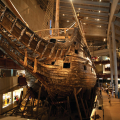An impressive museum, exhibiting the 17th century royal ship, rescued from the depths of the sea...
This museum exhibits the onlyseventeenth-century ship that is 98% preserved. Inside, in addition to the immense ship, you'll find skeletons of sailors who died during the sinking, films on the history of the royal vessel, hundreds of objects found in the wreck, computer simulators to see if you could have prevented the warship from sinking on her maiden voyage..
Practical. Exhibitions illustrate the history of the ship and its era. The auditorium shows a film dedicated to the Vasa, projected in French during the high season. Guided tours, which last 25 minutes, are in English, but it is possible to download an audioguide in French from the museum's app, directly onto your phone. Due to the current terrorist threat, lockers are temporarily inaccessible at the museum entrance, and suitcases are also refused. From the museum's backyard, the view is over the beautiful islands of Skeppsholmen and Kastellholmen, and behind the museum are moored two other ships, one a lightship and the other an icebreaker, also open to visitors.
The new museum Inaugurated in 1990 by King Charles XVI Gustavus, this 12,540 m² building is one of a kind, and is now one of Stockholm's major attractions. The ship, located at the bottom of an old 1879 dry dock, sits at the center of the vast hall. The entrance is at the supposed waterline, and the paved floor is reminiscent of a quay. The concrete ceiling rises high above the deck, to make room for the two original bas-masts and copies of the mizzen and bowsprit bas-masts. The ceiling then drapes down to almost ground level on one side of the building. The upper parts of the masts, which are missing, are evoked on the outside by the highly stylized masthead that surmounts the museum's copper roof. Galleries are provided for the public on six levels (numbered 2 to 7), from the keel to the top of the rear castle. The walls are either rough-cast or painted concrete. In addition to the paved sections, the floors are of pine and limestone.
History of the royal vessel Vasa. A true work of art. On January 16, 1625, King Gustav II Adolphus signed a contract with shipbuilder Henrik Hybertsson to build the Vasa. Over a thousand oak trees were felled in preparation for the work. The following year, work began on the Vasa at Skeppsgården, on Blaiseholmen, in the heart of Stockholm, on Nybrokajen quay. Four hundred men took part, and the bronze cannons began to be cast. When the builder died in 1627, Hein Jakobsson was entrusted with the rest of the work. For three years, carpenters, sawyers, tailors, glassmakers, sailmakers, painters, buffetiers, woodcarvers and other tradesmen worked on the construction of the new navy vessel, a royal ship, a name reserved in the 17thcentury for the largest warships. The Vasa, with its 64 large-caliber cannons and masts over 50 m high (the only additions to the ship), was destined to be its flagship. Not only the cannons, but also the profusion of carvings make the ship particularly impressive: a roaring lion's head, demons, warriors, minstrels, emperors and gods... In all, 400 carved figures and 300 carved wooden ornaments. The lion symbolized the Swedish king and power in his struggle against the Catholics and the German emperor. For his contemporaries, Gustav II Adolphus was the Lion of the North.
In 1628, the ship was moored at the foot of the royal castle, and ballast, cannonballs and cannons were brought aboard. On August 10, a Sunday, the Vasa set sail on her maiden voyage. It was to be her last... because a sudden gust of wind capsized the ship and she sank just off the island of Djurgården, after a 1,300 m voyage. No one was to blame for the disaster. Attempts to refloat the vessel failed.
Discovery and refloating. In the 1950s, Anders Franzén, an engineer with a passion for archaeology, set out to find the Vasa in the waters off Stockholm, in the hope of recovering it in good condition. For years, however, the harbor waters yielded nothing but old bicycles, rusty furnaces and dead cats. In 1956, Franzén's efforts, aided by diver Per Edvin Fälting, finally paid off: the vessel was spotted off the islet of Beckholmen. The two men put all their energy into rescuing her. In 1957, the French Navy and the Neptun company decided to take part in the salvage operation. Scuba divers dug tunnels under the building, bringing well-preserved sculptures to the surface. In 1959, thick ropes were passed under the ship and the Neptun company brought her back to shallower water. The final refloating took place on April 24, 1961. When, after 333 years, the ship resurfaced, the sailors' trunks were still loaded with food, clothing and small personal items. Barrels of meat were stowed in the hold, and the admiral's table was in place in his cabin. It's all there: the fine pewter services of the officers, the bronze candlesticks, the lanterns...! In the years that followed, divers continued to search the seabed, bringing back hundreds of wooden sculptures. The Vasa has been installed on a concrete pontoon to serve as a temporary museum.
Did you know? This review was written by our professional authors.
Members' reviews on VASA MUSEUM (VASAMUSEET)
The ratings and reviews below reflect the subjective opinions of members and not the opinion of The Little Witty.














